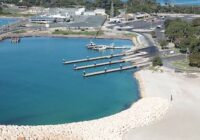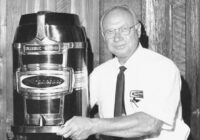Part 1: Creating a New Flagship – The Riviera 78 Motor Yacht
When Riviera revealed designs for a new class of motor yacht in May 2021, the company’s New Product Introduction team was already hard at work building the first 78 Motor Yacht.
Concepts and planning for this exceptional new motor yacht had begun in 2019 through detailed discussions with a number of highly experienced owners.
They met Riviera’s New Product Introduction (NPI) Manager Warren Maslen as the hull and deck of the first 78 Motor Yacht were being joined.
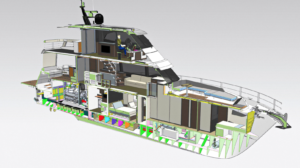
Warren’s primary role at Riviera is to develop and document the build process for every model to allow the boat builders, engineers, electricians, carpenters and many other specialists to facilitate the efficient and exacting build of every yacht. “Attention to detail is the keystone of the Riviera team, and this is certainly exemplified in the new 78 Motor Yacht,” explained Warren.
Warren joined Riviera in 2007, initially working on fitting out Riviera Sport Yachts. After spending many years on the boatbuilding production line, Warren’s skills, experience, and passion for making highest quality was recognised and he was asked to join the NPI team. Very quickly he progressed to the leadership role.
Designing a flagship
Utilising sophisticated 3D computer-aided design technology, the Riviera design team worked on concepts for the 78 Motor Yacht in collaboration with international superyacht designer Luca Vallebona. Their combined passion for excellence saw the development of plans for a sophisticated yacht that would deliver a perfect combination of family cruising, entertaining and blue-water passage-making capabilities.
The 78 Motor Yacht will be offered with an enclosed or open bridge deck and includes accommodation for up to 10 adults in four luxurious staterooms and crew quarters.
The saloon and bridge decks both extend through to the stern of the yacht, offering multiple dining, entertaining and relaxing spaces for parties, family gatherings or more quiet moments.
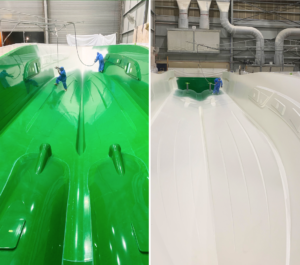
With the initial design completed, the new product development team took up the challenge to develop comprehensive mock-ups of the entire yacht and invited the owners who had contributed to the initial concept design to inspect the mock-up, either personally or via a video tour, and offer feedback. Overwhelmingly, the comments were extremely positive – to the extent that six owners soon placed orders.
Attention to detail is the keystone of the Riviera team, and this is certainly exemplified in the new 78 Motor Yacht.
Just one example of dedication to design is that of the helm. The layout in the mock-up included a central helm seat and companion seats on either side. A large amount of time was invested by the design team in checking the ergonomics of the helm. As with every aspect of the yacht, the designers had the benefit of many years of experience and owner and dealer representative feedback, most recently from the Sports Motor Yachts. With this new yacht the team went even further in seeking excellence.
The 78 Motor Yacht owners are enthusiastic that they will be involved in every step of their build, so each yacht will include a range of bespoke elements throughout to reflect their personal tastes and lifestyles.
With a thorough review of all feedback completed, and taking on board a range of suggestions, the design team refined the CAD modelling before computer-generated CNC routers cut plugs for every single component of what is destined to be a magnificent yacht.
Each plug was sanded in great detail before a coat of Duratech was added to ensure a perfect seal and then carefully finished to a mirror shine. The non-skid finishes along the decks were added to the plug. These stippled elements are a particular challenge for boat builders as they can cause the mould to not release completely from the plug. The Riviera team has refined the process and the moulds came away cleanly. In turn, each mould was treated and thoroughly cleaned before lamination of each component could begin.
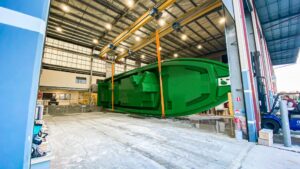
At the same time, team members were working on the many small parts that will be utilised in this yacht, including hatches, barbecue units, wet bar units and many more. Every part is 3D CAD designed and then the plugs are CNC five-axis cut to millimetre accuracy. They are then further sanded and refined to ensure a superiority of finish throughout the yacht.
Each yacht will include more than 180 small parts, many requiring multiple moulds resulting in over 300 separate moulds.
Final engineering and electrical drawings were completed to allow the team to exactly position these components.
The deck was moulded from its plug while seated on the hull plug to ensure millimetre accuracy when the final hull and deck were joined. The hull plug and deck mould were then wheeled outside of the lamination facility. The deck mould was then carefully lifted off the hull plug by three huge cranes. High in the air, the cranes worked in perfect unison to roll the mould over before it was returned to the shed for lamination.
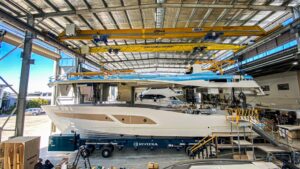
Now the build of the first 78 Motor Yacht could begin.
Bulkheads and even the crew quarters and master en-suite were built into the hull. These elements are usually included with the deck and headliner. However, the 78 has been designed with more than a single headliner as one of the many weight-saving decisions. Adding the crew space and master en-suite directly into the hull has the added benefit of even greater structural rigidity.
Most of the electric cabling – which is kilometres in length – was installed as team members worked on the hull. Usually, most of the electrical and other cabling is installed with the headliner and many of the connections completed after the deck is joined to the hull. This new method gives the team much greater space in which to work to ensure the quality of the layout.
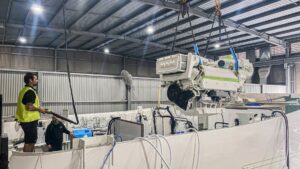
The MAN turbo diesel engines were test-fitted into the engine-room compartment of the hull, then lifted out while fine adjustments were made before final installation and connection to the V-drive gearboxes and oil-filled shafts.
The large structures on the yacht, including the hull and deck, are skilfully hand laid. The hull is solid fibreglass to 200mm above the chines.
Above that, the hull includes a foam core. A collision bulkhead is built into the bow area. The deck includes foam core to reduce weight while maintaining strength, and the flybridge and the hardtop are infused to further save weight while adding strength.
The careful work to ensure millimetre accuracy between hull and deck resulted in a perfect fit and the yacht moved to the fitout stage when the team began to build the accommodation deck in detail.
With multiple orders for this brilliant new motor yacht in place, the team has already begun work on laminating the giant hull of 78MY number two.
Part 2: Magnificent 78 Motor Yacht prepares for launch
She stands resplendent with her newly painted silver-grey hull on the riverside apron of Riviera’s yard on Queensland’s Gold Coast. Massive, tinted windows dominate the forward half of the hull on either side.
The new flagship Riviera 78 Motor Yacht is undergoing her detailed interior fitout here before initial sea trials.
The next feature of note as you approach the yacht is the large teak-laid swim platform recently fitted to her stern. It was developed in co-operation with Italian firm Opacmare to provide a three-step design that can be lowered down to a metre into the water to make access simple both for swimming and launching water sports equipment from the large garage that is beneath the saloon deck. An electrically operated door lifts up to provide access. The underside of the door even includes a fresh-water shower to wash away salt water before stepping up to the saloon deck.
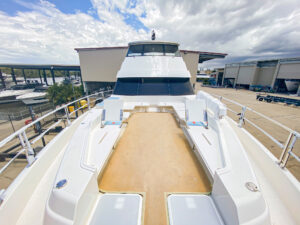
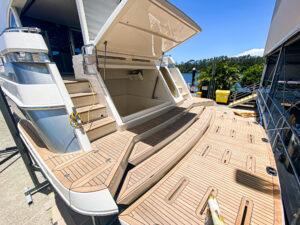
Beside the garage is where a watertight door will be fitted, leading to the cavernous full-head-height engine room via a cleverly designed workspace.
On the foredeck, the expansive entertaining space awaits soft furnishings. An integrated davit has now been fitted, ready to lift the tender.
Work is focusing on the saloon deck that stretches to the transom, protected from the elements by the bridge deck overhang that also extends to the transom. An optional electrically operated vertical screen has been fitted to the aft of this space for further weather protection, particularly for guests seated on the lounge that will run across the transom.
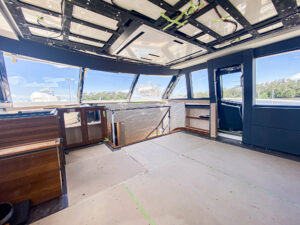
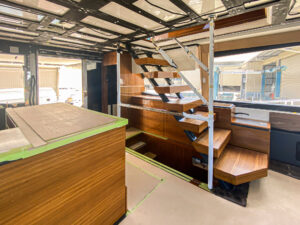
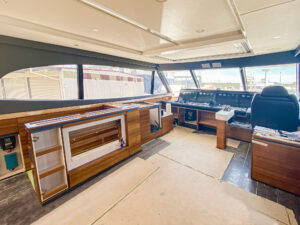
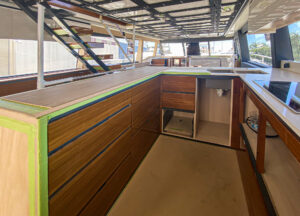
The saloon and bridge deck layouts provide many options for owners to select from. The aft saloon deck of this first yacht will have a lounge across the transom facing a fold-out dining table and an L-shape lounge in the starboard fore quarter and a barbecue unit to port. Optionally, the dining table could be located forward the starboard lounge.
An electric sliding door opens to reveal the interior of the saloon deck with its large U-shape galley immediately to starboard, positioned to serve guests equally on the aft deck or in the saloon. The galley features Caesarstone benchtops that display a three-burner hob and twin underslung stainless-steel sinks. The twin ovens, a dishwasher and a pair of full-height refrigerators are yet to be brought on board. All the highly polished teak cabinetry already fitted includes concealed latches and drawers with soft-close mechanisms.
Ceasarstone has also been selected for the interior bridge and saloon wet bars benchtops.
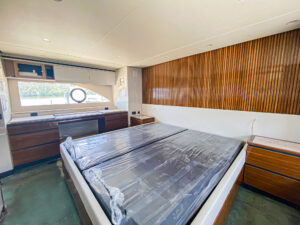
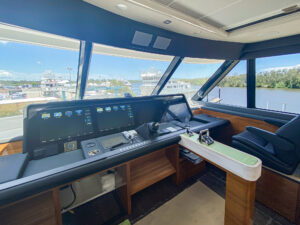
Opposite the galley are two staircases, now complete; floating treads lead to the bridge deck above and the second staircase leads below to the crew quarters and engine room.
A curved timber staircase at the forward end of the saloon space leads to the accommodation deck with its four staterooms and three bathrooms. Fitout of this space is almost complete, revealing for the first time the expansive volume and luxury of the master suite amidships with the king-size bed on the centreline. The very large hull windows fitted with opening portholes introduce a huge amount of natural light. A walk-in wardrobe is in the starboard fore quarter and the bathroom, with a separate toilet, in the port fore quarter now features white Valente Grigio wall detailing. A similar wall treatment is featured in the VIP guest bathroom forward.
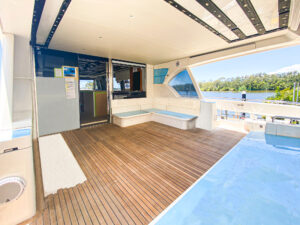
The bridge deck space is very impressive – approximately 10 metres (33 feet) from the helm to the transom rail.
Two of the forward helm’s four navigation screens are already fitted and bases await the installation of the Opacmare central helm and two companion seats.
A wet bar on the aft section of the bridge deck has been fitted.
A pair of small hatches in the aft quarter coaming of the bridge deck conceal joysticks that are part of the yacht’s Twin Disc Electronic JoyStick system (EJS).
The furniture for this yacht is yet to be brought on board. Each owner will specify how the saloon and bridge decks are to be fitted out.
Part 3: Magnificent new 78 Motor Yacht prepares for launch
Now she has truly come together to provide all who see her with a comprehensive impression of the yacht that will make her world premiere early 2022.
With much of the engineering work complete, the next step was to bring the superstructure together to create the enormous bridge deck that extends over the saloon deck almost to the transom.
The bridge deck was assembled separately from the main body of the yacht with the frame that separates the interior from the aft deck area installed, the windscreen lowered into place and the steel frames for the electric side windows also positioned.
The hardtop, with its electronic wiring ready for TV and radar domes and the giant electric sunroof, was completed and precisely lowered onto the bridge deck superstructure.
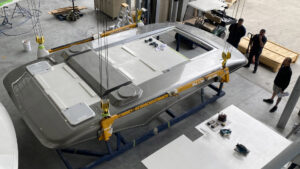
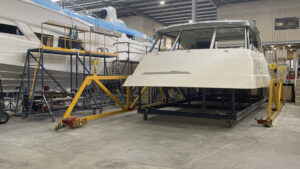
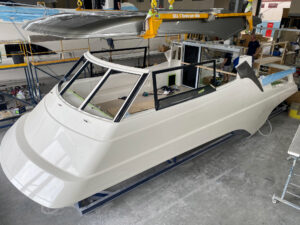
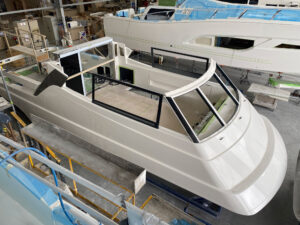
The entire assembly was then lifted over the yacht and carefully lowered into place. The millimetre accuracy of computer-aided design and moulding ensured that the major components of this yacht – the deck onto the hull, the bridge deck superstructure onto the main deck and the hardtop above it – all have a precision fit.
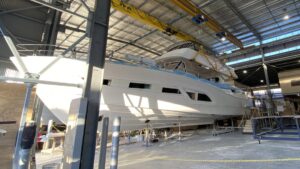
Then came the first dramatic moment for the 78 Motor Yacht as she was lifted onto Riviera’s remote-controlled TM100 transporter and brought out into the bright sunshine of an early spring day. She was delivered to the Riviera travel-lift bay at the marina and carefully lowered into the water for the first time.
Riviera’s New Product Introduction (NPI) Manager Warren Maslen explains that this process is to ensure that her waterline is as predicted by the computer modelling.
“She is beautifully balanced and floats as we designed,” he says. “She will settle slightly lower in the water after we have completed the fitout of the yacht. While this first test is always a little demanding for the team, it is comprehensive proof of our design systems and approach.” The yacht was then returned to the substantial fitout facility where the skilled craftspeople continued the exacting task of completing the detailed work.
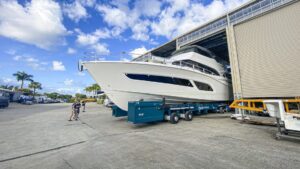
During an inspection of the timber shop, Warren explained that a robotic spray machine had been utilised to coat the many highly varnished timber panels that were already in racks ready to move across to the fitout facility when required. The robotic machine ensures an even coat across every panel.
He also displayed a set of the many hundreds of small timber parts, each with computer-generated drill holes.
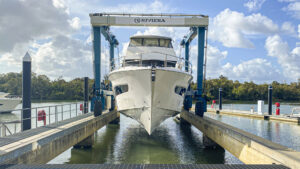
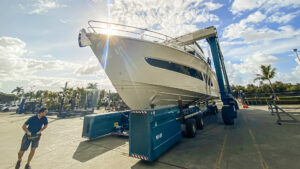
“We know from this that every screw required will be in exactly the right place,” he says.
Drawers include sturdy soft-close mechanisms.
“There are some 5000 individual parts aboard this yacht,” says Warren. “Our build manual shows me where each one is to be positioned.”
Back on board the yacht, the teak decks of both the saloon and bridge decks have already been laid. The galley space in the middle of the saloon deck is marked out.
This first 78 Motor Yacht includes an optional head on the bridge deck and is already in place.
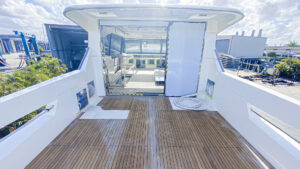
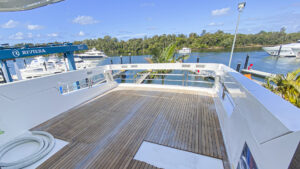
In coming weeks, the saloon and bridge deck cabinetry will be assembled and brought on board and the fitout of the four staterooms and four bathrooms will begin.
Our next visit to the Riviera 78 Motor Yacht will see her going through an extensive quality control process and final preparation ahead of her launch.
All images and text courtesy of Riviera.





